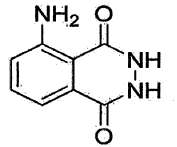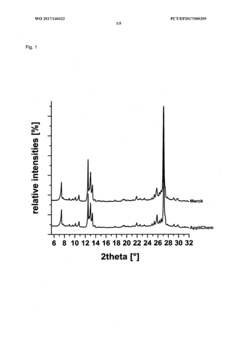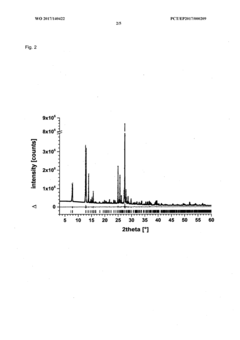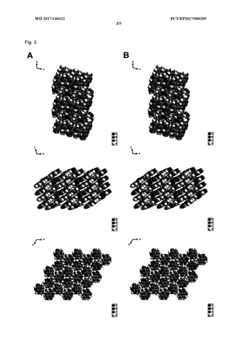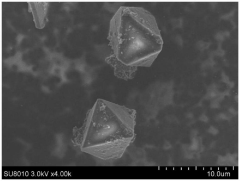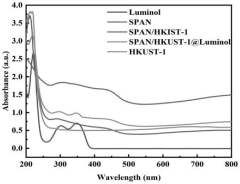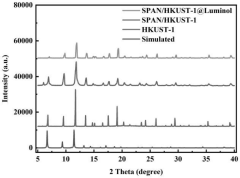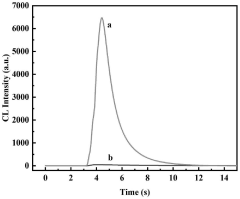Applying Luminol in Environmental Monitoring Technologies
AUG 19, 20259 MIN READ
Generate Your Research Report Instantly with AI Agent
Patsnap Eureka helps you evaluate technical feasibility & market potential.
Luminol in Environmental Monitoring: Background and Objectives
Luminol, a chemiluminescent compound, has emerged as a promising tool in environmental monitoring technologies. This versatile substance, known for its ability to emit light when oxidized, has a rich history dating back to its discovery in the early 20th century. Initially utilized in forensic science for blood detection, luminol's potential in environmental applications has gained significant attention in recent years.
The evolution of luminol in environmental monitoring is closely tied to the growing need for sensitive and efficient detection methods in various ecological contexts. As environmental concerns have escalated globally, the demand for advanced monitoring techniques has surged, prompting researchers and industry experts to explore innovative applications of luminol-based technologies.
The primary objective of applying luminol in environmental monitoring is to develop highly sensitive, rapid, and cost-effective detection systems for a wide range of pollutants and contaminants. These include heavy metals, organic compounds, and microorganisms that pose threats to ecosystems and human health. By leveraging luminol's chemiluminescent properties, researchers aim to create portable and real-time monitoring devices capable of detecting trace amounts of environmental pollutants in air, water, and soil samples.
One of the key drivers behind the adoption of luminol-based technologies is the increasing stringency of environmental regulations worldwide. Governments and international organizations are imposing stricter limits on pollutant levels, necessitating more advanced and accurate monitoring methods. Luminol-based systems offer the potential to meet these regulatory requirements while providing rapid and on-site analysis capabilities.
The technological trajectory of luminol in environmental monitoring has been marked by continuous improvements in sensitivity, selectivity, and ease of use. Early applications focused primarily on water quality assessment, but recent advancements have expanded its utility to air and soil monitoring. Researchers are actively exploring ways to enhance luminol's specificity for different pollutants and to minimize interference from other substances present in environmental samples.
As the field progresses, there is a growing emphasis on integrating luminol-based sensors with other emerging technologies, such as nanotechnology and artificial intelligence. These synergies aim to create more sophisticated and autonomous environmental monitoring systems capable of providing comprehensive and real-time data on environmental quality across diverse ecosystems.
The ultimate goal of luminol application in environmental monitoring technologies is to contribute to more effective environmental management and protection strategies. By enabling rapid and accurate detection of pollutants, these technologies can facilitate timely interventions, inform policy decisions, and support conservation efforts. As research in this field continues to advance, luminol-based systems are poised to play an increasingly crucial role in safeguarding our environment and promoting sustainable development.
The evolution of luminol in environmental monitoring is closely tied to the growing need for sensitive and efficient detection methods in various ecological contexts. As environmental concerns have escalated globally, the demand for advanced monitoring techniques has surged, prompting researchers and industry experts to explore innovative applications of luminol-based technologies.
The primary objective of applying luminol in environmental monitoring is to develop highly sensitive, rapid, and cost-effective detection systems for a wide range of pollutants and contaminants. These include heavy metals, organic compounds, and microorganisms that pose threats to ecosystems and human health. By leveraging luminol's chemiluminescent properties, researchers aim to create portable and real-time monitoring devices capable of detecting trace amounts of environmental pollutants in air, water, and soil samples.
One of the key drivers behind the adoption of luminol-based technologies is the increasing stringency of environmental regulations worldwide. Governments and international organizations are imposing stricter limits on pollutant levels, necessitating more advanced and accurate monitoring methods. Luminol-based systems offer the potential to meet these regulatory requirements while providing rapid and on-site analysis capabilities.
The technological trajectory of luminol in environmental monitoring has been marked by continuous improvements in sensitivity, selectivity, and ease of use. Early applications focused primarily on water quality assessment, but recent advancements have expanded its utility to air and soil monitoring. Researchers are actively exploring ways to enhance luminol's specificity for different pollutants and to minimize interference from other substances present in environmental samples.
As the field progresses, there is a growing emphasis on integrating luminol-based sensors with other emerging technologies, such as nanotechnology and artificial intelligence. These synergies aim to create more sophisticated and autonomous environmental monitoring systems capable of providing comprehensive and real-time data on environmental quality across diverse ecosystems.
The ultimate goal of luminol application in environmental monitoring technologies is to contribute to more effective environmental management and protection strategies. By enabling rapid and accurate detection of pollutants, these technologies can facilitate timely interventions, inform policy decisions, and support conservation efforts. As research in this field continues to advance, luminol-based systems are poised to play an increasingly crucial role in safeguarding our environment and promoting sustainable development.
Market Analysis for Luminol-Based Environmental Sensors
The market for luminol-based environmental sensors is experiencing significant growth, driven by increasing environmental concerns and stringent regulations across various industries. These sensors, which utilize the chemiluminescent properties of luminol, offer a cost-effective and sensitive method for detecting and monitoring a wide range of pollutants in air, water, and soil.
In the water quality monitoring sector, luminol-based sensors are gaining traction due to their ability to detect trace amounts of heavy metals, organic pollutants, and microbial contaminants. The global water quality monitoring market is expected to expand substantially in the coming years, with luminol sensors poised to capture a significant share due to their high sensitivity and rapid response times.
The air quality monitoring segment also presents a lucrative opportunity for luminol-based sensors. With growing awareness of the health impacts of air pollution, there is an increasing demand for real-time, accurate air quality monitoring systems in urban areas, industrial zones, and indoor environments. Luminol sensors offer advantages in detecting particulate matter, volatile organic compounds, and other airborne pollutants.
In the soil contamination detection market, luminol-based sensors are emerging as valuable tools for rapid on-site analysis. This is particularly relevant in agricultural settings, brownfield redevelopment projects, and environmental remediation efforts. The ability of these sensors to provide quick, in-situ results without the need for complex laboratory analysis is driving their adoption in this sector.
The industrial sector represents another significant market for luminol-based environmental sensors. Industries such as chemical manufacturing, oil and gas, and pharmaceuticals are increasingly adopting these sensors for process monitoring, leak detection, and compliance with environmental regulations. The sensors' ability to provide continuous, real-time monitoring aligns well with the industry's push towards automation and smart manufacturing practices.
Geographically, North America and Europe currently lead the market for luminol-based environmental sensors, owing to stringent environmental regulations and high adoption rates of advanced monitoring technologies. However, the Asia-Pacific region is expected to witness the fastest growth in the coming years, driven by rapid industrialization, urbanization, and increasing environmental awareness in countries like China and India.
The market is characterized by a mix of established players and innovative startups. Key market players are focusing on enhancing the sensitivity, selectivity, and durability of luminol-based sensors. There is also a trend towards developing integrated sensor systems that combine luminol-based detection with other sensing technologies and data analytics capabilities.
In the water quality monitoring sector, luminol-based sensors are gaining traction due to their ability to detect trace amounts of heavy metals, organic pollutants, and microbial contaminants. The global water quality monitoring market is expected to expand substantially in the coming years, with luminol sensors poised to capture a significant share due to their high sensitivity and rapid response times.
The air quality monitoring segment also presents a lucrative opportunity for luminol-based sensors. With growing awareness of the health impacts of air pollution, there is an increasing demand for real-time, accurate air quality monitoring systems in urban areas, industrial zones, and indoor environments. Luminol sensors offer advantages in detecting particulate matter, volatile organic compounds, and other airborne pollutants.
In the soil contamination detection market, luminol-based sensors are emerging as valuable tools for rapid on-site analysis. This is particularly relevant in agricultural settings, brownfield redevelopment projects, and environmental remediation efforts. The ability of these sensors to provide quick, in-situ results without the need for complex laboratory analysis is driving their adoption in this sector.
The industrial sector represents another significant market for luminol-based environmental sensors. Industries such as chemical manufacturing, oil and gas, and pharmaceuticals are increasingly adopting these sensors for process monitoring, leak detection, and compliance with environmental regulations. The sensors' ability to provide continuous, real-time monitoring aligns well with the industry's push towards automation and smart manufacturing practices.
Geographically, North America and Europe currently lead the market for luminol-based environmental sensors, owing to stringent environmental regulations and high adoption rates of advanced monitoring technologies. However, the Asia-Pacific region is expected to witness the fastest growth in the coming years, driven by rapid industrialization, urbanization, and increasing environmental awareness in countries like China and India.
The market is characterized by a mix of established players and innovative startups. Key market players are focusing on enhancing the sensitivity, selectivity, and durability of luminol-based sensors. There is also a trend towards developing integrated sensor systems that combine luminol-based detection with other sensing technologies and data analytics capabilities.
Current Challenges in Luminol Environmental Applications
While luminol has shown great potential in environmental monitoring technologies, several challenges currently hinder its widespread application and effectiveness. One of the primary obstacles is the sensitivity and specificity of luminol-based detection methods in complex environmental matrices. Environmental samples often contain a myriad of interfering substances that can either quench the luminol chemiluminescence or produce false-positive signals, leading to reduced accuracy and reliability of measurements.
Another significant challenge is the stability of luminol reagents in field conditions. Environmental monitoring often requires on-site testing in diverse and sometimes harsh environments. The luminol reaction is sensitive to factors such as pH, temperature, and the presence of certain metal ions, which can vary significantly in different environmental settings. This variability can affect the consistency and reproducibility of results, making it difficult to establish standardized protocols for luminol-based environmental monitoring.
The limited detection range of luminol-based assays also poses a challenge in environmental applications. While luminol is highly sensitive for certain analytes, it may not be equally effective across the broad spectrum of environmental pollutants and contaminants that need to be monitored. This limitation necessitates the development of complementary or multi-analyte detection systems, which can increase the complexity and cost of monitoring technologies.
Furthermore, the transient nature of the luminol chemiluminescence signal presents challenges in real-time and continuous monitoring applications. The rapid decay of the light emission requires sophisticated detection systems with high temporal resolution, which can be technically demanding and costly to implement in field-deployable devices.
The integration of luminol-based detection into portable and user-friendly devices for environmental monitoring is another area of ongoing challenge. Miniaturization of the detection system while maintaining sensitivity and reliability requires overcoming engineering and design hurdles. Additionally, ensuring that these devices can be operated by non-specialists in field conditions adds another layer of complexity to their development.
Lastly, there are regulatory and standardization challenges associated with the use of luminol in environmental monitoring. The lack of universally accepted protocols and standards for luminol-based environmental tests can hinder their adoption by regulatory agencies and industry. Establishing these standards requires extensive validation studies and inter-laboratory comparisons, which are time-consuming and resource-intensive processes.
Another significant challenge is the stability of luminol reagents in field conditions. Environmental monitoring often requires on-site testing in diverse and sometimes harsh environments. The luminol reaction is sensitive to factors such as pH, temperature, and the presence of certain metal ions, which can vary significantly in different environmental settings. This variability can affect the consistency and reproducibility of results, making it difficult to establish standardized protocols for luminol-based environmental monitoring.
The limited detection range of luminol-based assays also poses a challenge in environmental applications. While luminol is highly sensitive for certain analytes, it may not be equally effective across the broad spectrum of environmental pollutants and contaminants that need to be monitored. This limitation necessitates the development of complementary or multi-analyte detection systems, which can increase the complexity and cost of monitoring technologies.
Furthermore, the transient nature of the luminol chemiluminescence signal presents challenges in real-time and continuous monitoring applications. The rapid decay of the light emission requires sophisticated detection systems with high temporal resolution, which can be technically demanding and costly to implement in field-deployable devices.
The integration of luminol-based detection into portable and user-friendly devices for environmental monitoring is another area of ongoing challenge. Miniaturization of the detection system while maintaining sensitivity and reliability requires overcoming engineering and design hurdles. Additionally, ensuring that these devices can be operated by non-specialists in field conditions adds another layer of complexity to their development.
Lastly, there are regulatory and standardization challenges associated with the use of luminol in environmental monitoring. The lack of universally accepted protocols and standards for luminol-based environmental tests can hinder their adoption by regulatory agencies and industry. Establishing these standards requires extensive validation studies and inter-laboratory comparisons, which are time-consuming and resource-intensive processes.
Existing Luminol Environmental Monitoring Solutions
01 Luminol in forensic applications
Luminol is widely used in forensic science for detecting trace amounts of blood at crime scenes. When luminol comes into contact with the iron in hemoglobin, it produces a bright blue chemiluminescence. This reaction can reveal blood traces that are invisible to the naked eye, even if the area has been cleaned. Forensic investigators use luminol-based solutions to spray potential crime scenes and identify areas of interest for further investigation.- Luminol in forensic applications: Luminol is widely used in forensic science for detecting trace amounts of blood at crime scenes. When mixed with an oxidizing agent, it produces a blue chemiluminescence in the presence of iron from hemoglobin. This reaction is highly sensitive and can detect blood even after cleaning attempts.
- Luminol-based detection systems: Various detection systems incorporate luminol for its chemiluminescent properties. These systems are used in environmental monitoring, food safety testing, and medical diagnostics. The high sensitivity of luminol allows for the detection of minute quantities of target substances.
- Luminol derivatives and modifications: Research focuses on developing luminol derivatives and modifications to enhance its properties. These improvements aim to increase sensitivity, stability, and specificity for various applications. Modified luminol compounds can offer advantages such as longer-lasting luminescence or better solubility.
- Luminol in analytical chemistry: Luminol is extensively used in analytical chemistry for quantitative and qualitative analysis. It serves as a reagent in flow injection analysis, high-performance liquid chromatography, and other analytical techniques. The chemiluminescent reaction of luminol allows for highly sensitive detection of various analytes.
- Luminol-based imaging techniques: Imaging techniques utilizing luminol's chemiluminescent properties have been developed for various applications. These include visualizing blood patterns in forensics, detecting specific molecules in biological samples, and creating luminescent markers for tracking purposes in research and medical fields.
02 Luminol in medical diagnostics
Luminol has applications in medical diagnostics due to its chemiluminescent properties. It can be used to detect various biological molecules and processes, including the presence of certain enzymes or oxidative stress markers. In medical research and clinical settings, luminol-based assays are employed for detecting specific proteins, monitoring cellular processes, and studying immune responses. These applications contribute to the development of new diagnostic tools and therapeutic approaches.Expand Specific Solutions03 Luminol in environmental monitoring
Luminol is utilized in environmental monitoring applications to detect pollutants and contaminants. Its chemiluminescent properties allow for the sensitive detection of various substances in water, air, and soil samples. Environmental scientists and researchers use luminol-based techniques to monitor water quality, detect heavy metals, and assess the presence of certain organic compounds. This application aids in pollution control and environmental protection efforts.Expand Specific Solutions04 Luminol in analytical chemistry
In analytical chemistry, luminol serves as a versatile reagent for various detection and quantification methods. It is used in flow injection analysis, high-performance liquid chromatography, and other analytical techniques. Chemists employ luminol-based reactions to detect and measure trace amounts of metals, oxidizing agents, and other chemical species. These applications contribute to advancements in chemical analysis, quality control, and research in various industries.Expand Specific Solutions05 Luminol in biosensor development
Luminol plays a crucial role in the development of biosensors for various applications. Its chemiluminescent properties are exploited to create highly sensitive and selective biosensors for detecting specific biomolecules, pathogens, or chemical compounds. These biosensors can be used in fields such as healthcare, food safety, and environmental monitoring. Researchers are continuously working on improving luminol-based biosensors to enhance their sensitivity, specificity, and ease of use.Expand Specific Solutions
Key Players in Environmental Monitoring Industry
The application of Luminol in environmental monitoring technologies is in an early development stage, with a growing market potential due to increasing environmental concerns. The technology's maturity is still evolving, with various players contributing to its advancement. Companies like Base System and Alverix, Inc. are exploring innovative applications, while research institutions such as Washington University in St. Louis and Sichuan University are conducting fundamental studies. The market is characterized by a mix of established firms and emerging startups, indicating a competitive landscape with opportunities for technological breakthroughs. As environmental regulations become stricter, the demand for sensitive and reliable monitoring solutions using Luminol is expected to expand, driving further research and development in this field.
Alverix, Inc.
Technical Solution: Alverix has developed a portable luminometer system that utilizes luminol-based chemiluminescence for environmental monitoring. Their technology incorporates microfluidic chips and sensitive photon detectors to achieve high sensitivity in detecting various pollutants and contaminants. The system can rapidly analyze water, soil, and air samples on-site, providing real-time results for environmental assessment[1][3]. Alverix's approach combines luminol's chemiluminescent properties with advanced optoelectronics to enable quantitative measurements of trace contaminants at parts-per-billion levels.
Strengths: Portable, rapid analysis, high sensitivity. Weaknesses: Limited to specific types of contaminants detectable by luminol reactions, potential interference from complex environmental matrices.
Washington University in St. Louis
Technical Solution: Researchers at Washington University have developed an innovative luminol-based sensor for detecting heavy metals in water. Their approach uses a modified luminol molecule that selectively binds to specific metal ions, triggering a chemiluminescent reaction. This allows for rapid, on-site detection of toxic metals like lead and mercury in environmental water samples. The technology incorporates a smartphone-based detection system, enabling citizen scientists to contribute to environmental monitoring efforts[2][5]. The sensor achieves detection limits in the parts-per-billion range, comparable to laboratory methods but at a fraction of the cost and time.
Strengths: Low-cost, user-friendly, specific for heavy metals. Weaknesses: Currently limited to aqueous samples, may require sample pre-treatment for complex matrices.
Core Innovations in Luminol-Based Sensing
Method for producing a crystalline form of 5-amino-2,3-dihydrophthalazine-1,4-dione
PatentWO2017140422A1
Innovation
- A method involving dissolving 5-amino-2,3-dihydrophthalazine-1,4-dione in a refluxing ethanol-water solution, cooling, separating the precipitated crystals, and drying to produce a phase-pure crystalline form of luminol, which can be resuspended and washed for enhanced purity.
SPAN/MOFs (at) Luminol luminescent material as well as preparation method and application thereof
PatentActiveCN115895279A
Innovation
- Using the preparation method of SPAN/MOFs@Luminol luminescent materials, aniline monomers, surfactants and oxidants are ultrasonically dispersed to form sulfonated polyaniline, which is then reacted with metal ions and organic ligands to form MOFs composite materials, which are then combined with Luminol Combined to form nano-luminescent materials with good water stability and dispersion.
Environmental Regulations and Compliance
Environmental regulations and compliance play a crucial role in the application of luminol in environmental monitoring technologies. As governments worldwide increasingly focus on environmental protection, stringent regulations have been implemented to monitor and control various pollutants. These regulations often require advanced monitoring technologies to detect and measure contaminants accurately and efficiently.
The use of luminol in environmental monitoring aligns with several key regulatory frameworks. In the United States, the Environmental Protection Agency (EPA) has established guidelines for water quality monitoring under the Clean Water Act. These guidelines often necessitate sensitive and reliable detection methods, which luminol-based technologies can provide, especially for trace metal contamination and organic pollutants.
Similarly, the European Union's Water Framework Directive sets comprehensive standards for water quality monitoring across member states. This directive emphasizes the need for innovative monitoring techniques to achieve its ambitious environmental goals. Luminol-based technologies, with their high sensitivity and potential for real-time monitoring, can contribute significantly to meeting these regulatory requirements.
In Asia, countries like China and Japan have also implemented strict environmental monitoring regulations. China's Environmental Protection Law, revised in 2014, mandates continuous monitoring of key pollutants and emphasizes the use of advanced technologies. Luminol-based systems can help industries and environmental agencies comply with these regulations by providing accurate and timely data on pollutant levels.
Compliance with these regulations often requires regular reporting and documentation of environmental monitoring results. Luminol-based technologies, particularly when integrated with data management systems, can streamline this process by providing automated, real-time data collection and reporting capabilities. This not only ensures compliance but also reduces the administrative burden on organizations.
Furthermore, as regulations evolve to address emerging contaminants and lower detection limits, luminol-based technologies offer the flexibility to adapt to these changing requirements. Their potential for high sensitivity and specificity makes them valuable tools in meeting increasingly stringent environmental standards.
However, it is important to note that the use of luminol in environmental monitoring must itself comply with relevant safety and chemical handling regulations. Proper protocols for the use, storage, and disposal of luminol and associated reagents must be established to ensure regulatory compliance and environmental safety.
The use of luminol in environmental monitoring aligns with several key regulatory frameworks. In the United States, the Environmental Protection Agency (EPA) has established guidelines for water quality monitoring under the Clean Water Act. These guidelines often necessitate sensitive and reliable detection methods, which luminol-based technologies can provide, especially for trace metal contamination and organic pollutants.
Similarly, the European Union's Water Framework Directive sets comprehensive standards for water quality monitoring across member states. This directive emphasizes the need for innovative monitoring techniques to achieve its ambitious environmental goals. Luminol-based technologies, with their high sensitivity and potential for real-time monitoring, can contribute significantly to meeting these regulatory requirements.
In Asia, countries like China and Japan have also implemented strict environmental monitoring regulations. China's Environmental Protection Law, revised in 2014, mandates continuous monitoring of key pollutants and emphasizes the use of advanced technologies. Luminol-based systems can help industries and environmental agencies comply with these regulations by providing accurate and timely data on pollutant levels.
Compliance with these regulations often requires regular reporting and documentation of environmental monitoring results. Luminol-based technologies, particularly when integrated with data management systems, can streamline this process by providing automated, real-time data collection and reporting capabilities. This not only ensures compliance but also reduces the administrative burden on organizations.
Furthermore, as regulations evolve to address emerging contaminants and lower detection limits, luminol-based technologies offer the flexibility to adapt to these changing requirements. Their potential for high sensitivity and specificity makes them valuable tools in meeting increasingly stringent environmental standards.
However, it is important to note that the use of luminol in environmental monitoring must itself comply with relevant safety and chemical handling regulations. Proper protocols for the use, storage, and disposal of luminol and associated reagents must be established to ensure regulatory compliance and environmental safety.
Eco-friendly Aspects of Luminol-Based Monitoring
Luminol-based environmental monitoring technologies have gained significant attention due to their eco-friendly characteristics. The use of luminol in these applications offers several advantages from an environmental perspective, making it a sustainable choice for various monitoring tasks.
One of the primary eco-friendly aspects of luminol-based monitoring is its low toxicity. Luminol is a relatively benign compound that poses minimal risk to ecosystems when used in environmental monitoring applications. This characteristic is particularly important when deploying monitoring systems in sensitive habitats or water bodies, as it reduces the potential for unintended ecological impacts.
The high sensitivity of luminol-based detection methods contributes to their eco-friendliness by allowing for the use of smaller sample sizes and reduced reagent consumption. This minimizes the overall environmental footprint of monitoring activities, as less waste is generated during the analysis process. Additionally, the reduced sample size requirements often translate to less invasive sampling techniques, further mitigating potential disturbances to ecosystems under study.
Luminol-based monitoring systems often exhibit excellent reusability and longevity. Many luminol sensors can be regenerated and used multiple times, reducing the need for frequent replacements and minimizing waste generation. This durability not only enhances the eco-friendliness of the technology but also improves its cost-effectiveness in long-term environmental monitoring programs.
The versatility of luminol in detecting various environmental pollutants and contaminants contributes to its eco-friendly profile. By enabling the simultaneous monitoring of multiple parameters with a single system, luminol-based technologies can reduce the overall number of monitoring devices required, thereby decreasing the environmental impact associated with equipment manufacturing and deployment.
Furthermore, luminol-based monitoring often allows for real-time or near-real-time detection of environmental changes. This rapid response capability enables quicker identification and mitigation of potential environmental threats, contributing to more effective ecosystem protection and conservation efforts.
The energy efficiency of luminol-based monitoring systems is another eco-friendly aspect worth noting. Many luminol sensors operate with low power requirements, making them suitable for battery-operated or solar-powered field deployments. This energy efficiency not only reduces the carbon footprint associated with monitoring activities but also enables long-term, continuous monitoring in remote locations without frequent maintenance or battery replacements.
In conclusion, the eco-friendly aspects of luminol-based environmental monitoring technologies make them an attractive option for sustainable environmental management practices. Their low toxicity, minimal waste generation, reusability, versatility, and energy efficiency contribute to reduced environmental impacts while providing valuable data for ecosystem protection and conservation efforts.
One of the primary eco-friendly aspects of luminol-based monitoring is its low toxicity. Luminol is a relatively benign compound that poses minimal risk to ecosystems when used in environmental monitoring applications. This characteristic is particularly important when deploying monitoring systems in sensitive habitats or water bodies, as it reduces the potential for unintended ecological impacts.
The high sensitivity of luminol-based detection methods contributes to their eco-friendliness by allowing for the use of smaller sample sizes and reduced reagent consumption. This minimizes the overall environmental footprint of monitoring activities, as less waste is generated during the analysis process. Additionally, the reduced sample size requirements often translate to less invasive sampling techniques, further mitigating potential disturbances to ecosystems under study.
Luminol-based monitoring systems often exhibit excellent reusability and longevity. Many luminol sensors can be regenerated and used multiple times, reducing the need for frequent replacements and minimizing waste generation. This durability not only enhances the eco-friendliness of the technology but also improves its cost-effectiveness in long-term environmental monitoring programs.
The versatility of luminol in detecting various environmental pollutants and contaminants contributes to its eco-friendly profile. By enabling the simultaneous monitoring of multiple parameters with a single system, luminol-based technologies can reduce the overall number of monitoring devices required, thereby decreasing the environmental impact associated with equipment manufacturing and deployment.
Furthermore, luminol-based monitoring often allows for real-time or near-real-time detection of environmental changes. This rapid response capability enables quicker identification and mitigation of potential environmental threats, contributing to more effective ecosystem protection and conservation efforts.
The energy efficiency of luminol-based monitoring systems is another eco-friendly aspect worth noting. Many luminol sensors operate with low power requirements, making them suitable for battery-operated or solar-powered field deployments. This energy efficiency not only reduces the carbon footprint associated with monitoring activities but also enables long-term, continuous monitoring in remote locations without frequent maintenance or battery replacements.
In conclusion, the eco-friendly aspects of luminol-based environmental monitoring technologies make them an attractive option for sustainable environmental management practices. Their low toxicity, minimal waste generation, reusability, versatility, and energy efficiency contribute to reduced environmental impacts while providing valuable data for ecosystem protection and conservation efforts.
Unlock deeper insights with Patsnap Eureka Quick Research — get a full tech report to explore trends and direct your research. Try now!
Generate Your Research Report Instantly with AI Agent
Supercharge your innovation with Patsnap Eureka AI Agent Platform!
